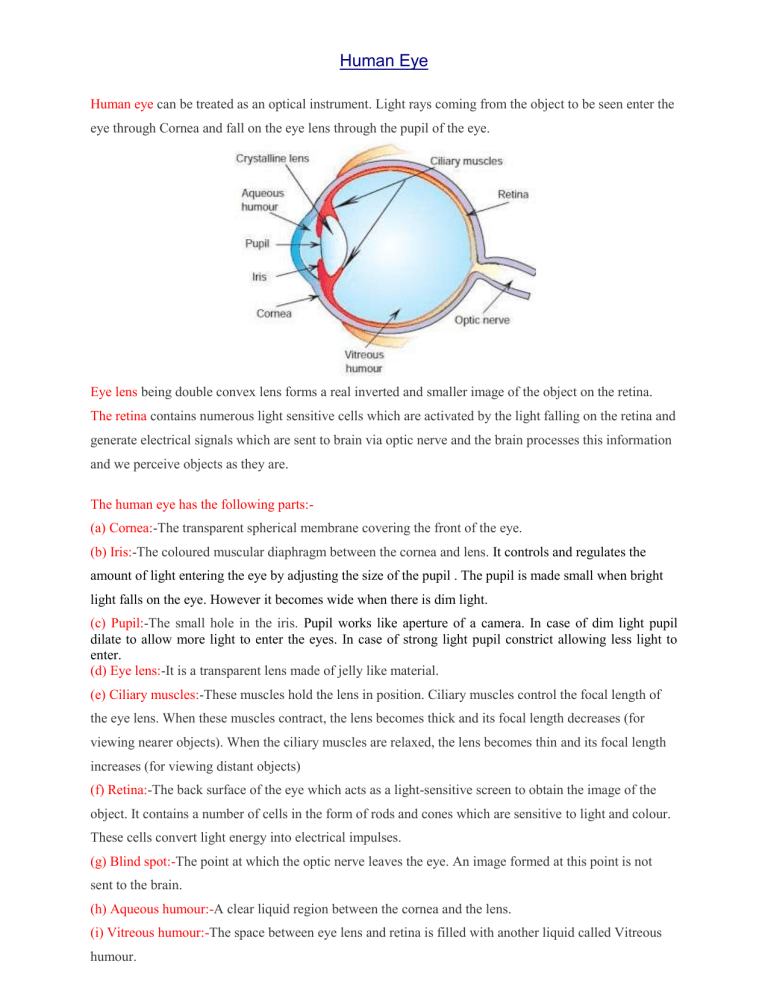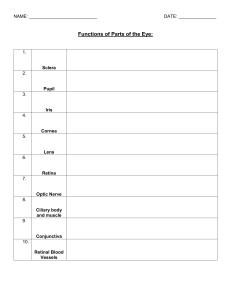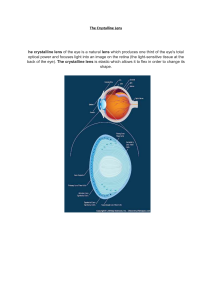
Human Eye Human eye can be treated as an optical instrument. Light rays coming from the object to be seen enter the eye through Cornea and fall on the eye lens through the pupil of the eye. Eye lens being double convex lens forms a real inverted and smaller image of the object on the retina. The retina contains numerous light sensitive cells which are activated by the light falling on the retina and generate electrical signals which are sent to brain via optic nerve and the brain processes this information and we perceive objects as they are. The human eye has the following parts:(a) Cornea:-The transparent spherical membrane covering the front of the eye. (b) Iris:-The coloured muscular diaphragm between the cornea and lens. It controls and regulates the amount of light entering the eye by adjusting the size of the pupil . The pupil is made small when bright light falls on the eye. However it becomes wide when there is dim light. (c) Pupil:-The small hole in the iris. Pupil works like aperture of a camera. In case of dim light pupil dilate to allow more light to enter the eyes. In case of strong light pupil constrict allowing less light to enter. (d) Eye lens:-It is a transparent lens made of jelly like material. (e) Ciliary muscles:-These muscles hold the lens in position. Ciliary muscles control the focal length of the eye lens. When these muscles contract, the lens becomes thick and its focal length decreases (for viewing nearer objects). When the ciliary muscles are relaxed, the lens becomes thin and its focal length increases (for viewing distant objects) (f) Retina:-The back surface of the eye which acts as a light-sensitive screen to obtain the image of the object. It contains a number of cells in the form of rods and cones which are sensitive to light and colour. These cells convert light energy into electrical impulses. (g) Blind spot:-The point at which the optic nerve leaves the eye. An image formed at this point is not sent to the brain. (h) Aqueous humour:-A clear liquid region between the cornea and the lens. (i) Vitreous humour:-The space between eye lens and retina is filled with another liquid called Vitreous humour. Persistence of vision: The image of an object seen persists on the retina for 1/16 second even after the removal of the object. This continuance of sensation of eye for some time is called persistence of vision. Power of Accomodation:-The ability of the eye to focus both near and distant objects, by adjusting the focal length, is called the power of accommodation of the eye. Far Point of the Eye: It is the farthest point at which the object can be seen clearly. For a normal eye, the far point lies at infinity. Near point of the Eye: It is the closest point at which an object can be seen clearly. For normal eye, the near point lies at 25 cm from the eye.(least distance of distinct vision) Colour blindness: It is said to occur when a person cannot distinguish between colours though his vision may otherwise be normal. Defects of vision 1. Myopia Myopia is also known as near-sightedness or short sightedness. A person with myopia can see nearby objects clearly but cannot see distant objects distinctly. In a myopic eye, the image of a distant object is formed in front of the retina and not at the retina itself. This defect may arise due to (i) excessive curvature of the eye lens, or (ii) elongation of the eyeball. This defect can be corrected by using a concave lens of suitable power. A concave lens of suitable power will bring the image back on to the retina and thus the defect is corrected. The focal length of concave lens is equal to the distance of the far point of the myopic eye. 2. Hypermetropia Hypermetropia is also known as far-sightedness or long sightedness A person with hypermetropia can see distant objects clearly but cannot see nearby objects distinctly. The near point, for the person, is farther away from the normal near point (25 cm). Such a person has to keep a reading material much beyond 25 cm from the eye for comfortable reading. This is because the light rays from a closeby object are focussed at a point behind the retina. This defect arises either because (i) the focal length of the eye lens is too long, or (ii) the eyeball has become too small. This defect can be corrected by using a convex lens of appropriate power. Eye-glasses with converging lenses provide the additional focussing power required for forming the image on the retina. 3. Presbyopia: The power of accommodation of the eye usually decreases with ageing. For most people, the near point gradually recedes away. They find it difficult to see nearby objects comfortably and distinctly without corrective eye-glasses. This defect is called Presbyopia. It arises due to the gradual weakening of the ciliary muscles and diminishing flexibility of the eye lens. Sometimes, a person may suffer from both myopia and hypermetropia. Such people often require bifocal lenses. A common type of bi-focal lenses consists of both concave and convex lenses. The upper portion consists of a concave lens. It facilitates distant vision. The lower part is a convex lens. It facilitates near vision. 4. Cataract: In old age the eye lens becomes cloudy. This reduces the vision in old age. In early stages of the disease cataract can be cured by eye surgery. Sometimes artificial lens is also transplanted during cataract surgery. This is called Intra Ocular Lens Transplantation.





